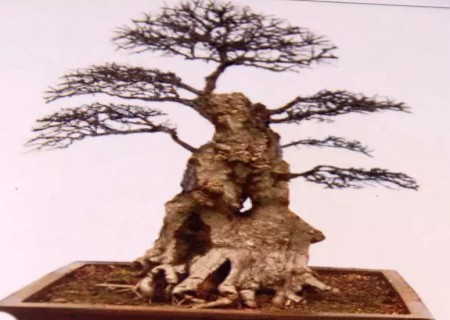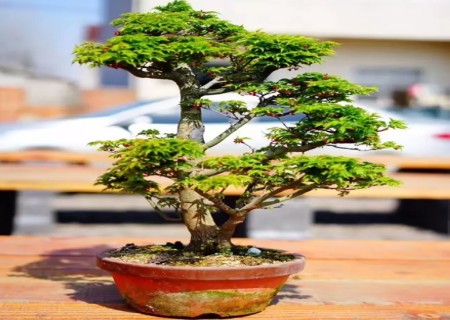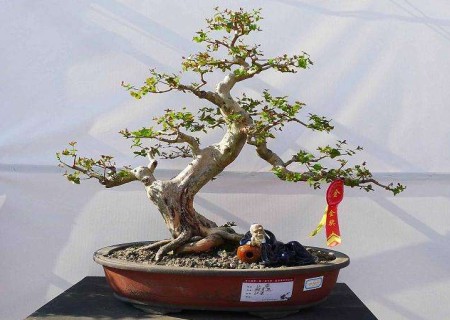Illustration of the method of storing branches in bonsai
As we all know, the styling beauty of bonsai needs to be done by pruning, which is the most commonly used means, but before pruning, we have to keep the branches of the plant strong. So, how do bonsai grow and grow branches? Next, the editor will share with you a graphic article on how to store branches of bonsai, hoping to give you some understanding and inspiration to create a beautiful bonsai.
Before we start to talk about growing branches, let's take a look at the following bonsai work. I don't know how you feel.

In fact, the presentation form of the branches and pile heads of this bonsai work alone is good, but from the overall point of view, it is somewhat incongruous. Why? It is obvious that the transition from trunk to branch is somewhat unnatural. Why did this happen? This is obviously too much pruning by the creator. If you look carefully, you can find that the first-class branches of the bonsai are pruned before they grow strong, and the consequence of pruning is that the later-level branches cannot grow sturdy and can't match the thickness of the trunk, so they don't look coordinated.
So, how can the first-class branch match the trunk? Please take a look at the diagram below:
This is the initial state of the pile, and we are sure to cut it dry after we dig it back. The following picture shows the shape after truncation, which is the effect of arranging the branches and roots:
When it comes to root treatment, let's talk about how the downhill pile organizes the root system. When we dig back the downhill pile, we need to cut off all its fibrous roots, otherwise it is easy to fake living. And the roots growing downwards should be kept as short as possible, because we have to take into account the depth of the basin. Of course, the works of Gautigen should be excluded.
Next, we are going to start growing first-class branches, which usually takes about 1-3 years. When the new branches grow to a certain stout degree and seem to match part of the trunk naturally, we choose to re-cut them before sprouting in early spring. Usually we can keep 1 or 2 buds in order for them to grow secondary branches. In fact, after 1-3 years of cultivation of first-class branches, the real use is in the short period after re-cutting, which is also a period of time to cultivate our endurance.
Of course, before re-cutting, we must figure out how the secondary, tertiary or even fourth-grade branches should be distributed and whether there is enough room for them to stretch. In addition, what kind of form the crown should be displayed, how long the branches and how many buds should be left, which should be considered in advance in our minds, so that the subsequent branches will not be left too long and pruned, which will not only waste time, but may also damage the plants.
Our method of cultivating secondary branches is basically the same as that of primary branches, that is, after re-pruning, the primary branches also need to erase the excess buds. At the same time, in order to promote the growth of the secondary branch, we also need to carry out the necessary banding, and timely adjust the growth direction and posture of the secondary branch. When the growth of the secondary branch coincides with that of the primary branch, we need to prune the secondary branch as we did before.
In general, the lower branches will be thicker and longer than the upper branches, so the branches will look more coordinated and grow into our triangular branches, which is usually the effect we need. That is to say, the primary branch is stronger than the secondary branch, and the secondary branch is stronger than the tertiary branch. Only by avoiding the long-span convergence above can it be more natural and look more coordinated.
In pruning and pruning, we generally recommend heavy pruning. It is not difficult to give up. Only when you have a house can you get it. Because when the primary and secondary branches are well managed, the molding process of the plant will become faster and faster in the future.
As long as we take the correct disposal method, for growing branches, we will get twice the result with half the effort. From the trunk to the top of the tree, the branches will grow more and more, and become finer and finer, and the time to store branches will be greatly shortened. The branches obtained by using this cultivation method will be thick and thin, link up naturally and harmoniously, and have more ornamental value and artistic effect compared with those branches that only rely on flat binding or distortion.
Time: 2019-06-08 Click:
- Prev

How to trim the stereotyped bonsai
The charm of plant bonsai is self-evident, and it is precisely because of its high artistic appreciation value that it can be favored by the majority of bonsai friends at home and abroad. In order to create a basin of masterpiece, it takes a lot of effort in modeling. Among the modeling techniques of bonsai plants, pruning is the most commonly used.
- Next

How to cut dry and store branches on bonsai stump
The main purpose of the shaping of branches by stump bonsai is to create the beauty of lines. However, in the process of practice, we should also use all kinds of artistic decoration techniques to make the branches cadence and rhythm as far as possible, so that our so-called lines can better reflect the sense of beauty.
Related
- Fuxing push coffee new agricultural production and marketing class: lack of small-scale processing plants
- Jujube rice field leisure farm deep ploughing Yilan for five years to create a space for organic food and play
- Nongyu Farm-A trial of organic papaya for brave women with advanced technology
- Four points for attention in the prevention and control of diseases and insect pests of edible fungi
- How to add nutrient solution to Edible Fungi
- Is there any good way to control edible fungus mites?
- Open Inoculation Technology of Edible Fungi
- Is there any clever way to use fertilizer for edible fungus in winter?
- What agents are used to kill the pathogens of edible fungi in the mushroom shed?
- Rapid drying of Edible Fungi

